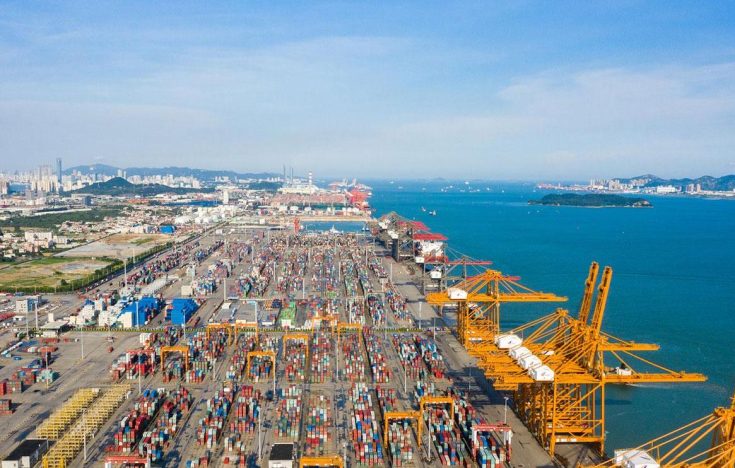This article is also available in Simplified Chinese.
While the rest of the world continues
to reel from the far-reaching effects of the Covid-19 pandemic, China is back
on its feet and moving toward an enviable rebound in 2021. In spite of a strong
recovery in exports and investment in infrastructure, though, domestic
consumption has been far slower to rebound. Reviving consumer demand will be
critical to achieving policymakers’ “dual circulation” economic strategy.
The coronavirus thwarted growth in the
world’s second-largest economy at the start of 2020.
As the rest of the world came to terms
with what the outbreak meant for them and their economies, China, impacted
first, also acted first. Travel restrictions were imposed, schools and
workplaces closed, factories shut, retail outlets and restaurants deserted as a
1.4 billion-strong population worked toward containing the spread of Covid-19.
China’s pioneering use of lockdowns
paid off. The economy has been recovering since March, helped by the
government’s actions to curb the virus as well as by fiscal and monetary
support.
The economy expanded by 3.2 percent
between April and June after a first quarter contraction, and BNP Paribas
expects full-year growth of 2.5 percent. Growth should rebound even more
strongly in 2021, but economists at BNP Paribas have just cut their forecast
for next year’s growth from 8.1 percent to 7.5 percent. Why?
There are three factors behind the
changed forecast, says Xingdong Chen, Chief China Economist at BNP Paribas.
“The lingering impact of Covid-19, less aggressive fiscal and monetary policy
next year and short-term loss in growth potential.”
Manufacturing and exports return to strength
“The supply-side recovery was definitely
much stronger than demand,” Mr Chen says, referring to a still-slow uptick in
domestic demand even as lockdown measures have been lifted. “Consumption has
remained underwater.”
Manufacturing activity has improved in
recent months as factories reopened and government stimulus boosted
infrastructure spending. The official Purchasing Manager’s Index for August
came in at 51, remaining above the 50-point mark that signifies expansion.
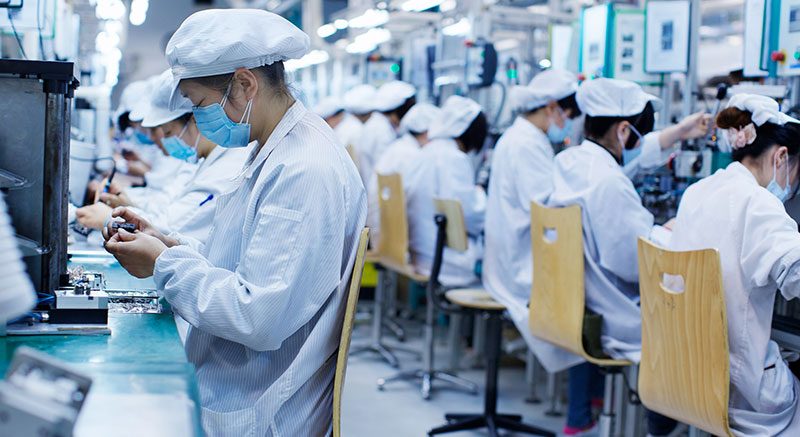
China’s exports are also rebounding
strongly. The latest data show a 9.5% year-on-year jump in August, the third
consecutive monthly increase.
“We expect the current growth momentum of exports to continue to remain through the end of the year or even early next year as we enter Christmas and New Year season.”
BNP Paribas
“The strong growth suggests China’s
export resilience,” says Mr. Chen of BNP Paribas. Besides underscoring China’s
dominant role in global trade, he adds, it is a strong signal that external
demand has ticked up as economies across the world gradually re-open. “We
expect the current growth momentum of exports to continue to remain through the
end of the year or even early next year as we enter Christmas and New Year
season,” he adds.
Domestic demand lags behind
Domestic demand has been slower to recover, though, as Chinese consumers remain cautious.
Retail sales in China still fell for a seventh consecutive month, down 1.1 percent y/y in July and -9.9 percent y/y over the first 7 months on average, as households that are grappling with job losses and uncertainty from the coronavirus outbreak remain reluctant to spend on non-essentials. Imports into China fell 2.1 percent in August, another indication that demand at home is still on the back foot, though partly attributing to the decrease in commodity prices.
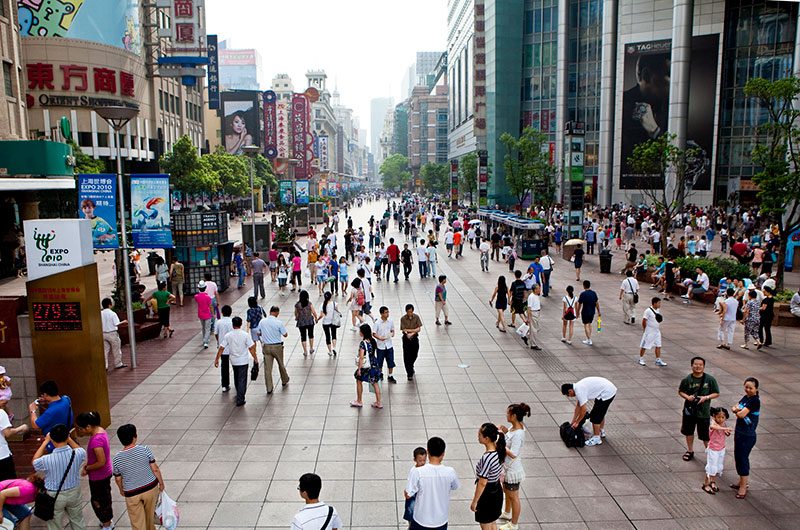
Under Chinese President Xi Jinping’s
“dual circulation” strategy, China will aim to rely on “internal circulation” –
or the domestic cycle of production, distribution and consumption – supported
by “external circulation.” The strategy is seen as a key measure in reducing
China’s reliance on overseas exports and technology imports at a time of rising
tensions with the U.S.
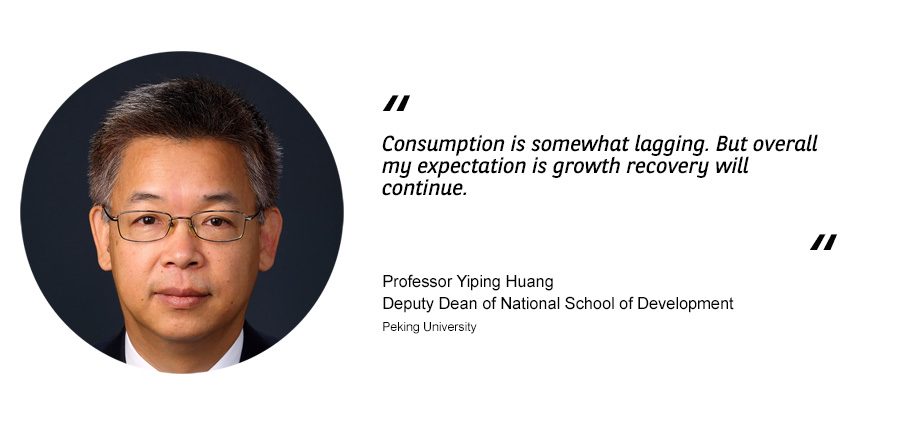
“Consumption is
somewhat lagging,” says Professor Yiping Huang, Deputy Dean of National
School of Development, Peking University.
“While the government’s fiscal policy focused on infrastructure, tax
exemptions and public health spending when the pandemic was hitting the
economy, we didn’t really have a lot of channels supporting households.”
“But overall my
expectation is growth recovery will continue,” he adds.
From monetary to fiscal stimulus
Since February, the People’s Bank of
China has delivered large amount of liquidity supply, multiple cuts to key lending
rates and banks’ reserve ratio requirements. It has also given targeted lending
support to firms impacted by the virus.
Still, the PBOC has steered clear of
large-scale stimulus measures like those adopted by its western counterparts.
And as China’s economic recovery takes hold, expectations of further monetary
policy support are dwindling. “Chinese policymakers are generally
satisfied with recovery growth performance so far,” says Mr. Chen.
BNP Paribas does not expect further
rate cuts, but believes that the government will instead intensify its
implementation of fiscal policy. Spending rose by 2.2 percent between January
and July versus a 12.4 percent target for the whole year, leaving plenty of
room for it to be ramped up if suitable investment projects or fiscal
programmes can be found. If not, a substantial amount of spending may be
delayed until next year, adds Mr. Chen. That means additional stimulus might
not be required.
U.S.-China tensions
Tensions between the U.S. and China
have clouded the outlook for Asia’s largest economy for more than two years and
there is no sign of these tensions easing. U.S. President Donald Trump’s tough
line on China continues in spite of the Phase One trade agreement in
February.
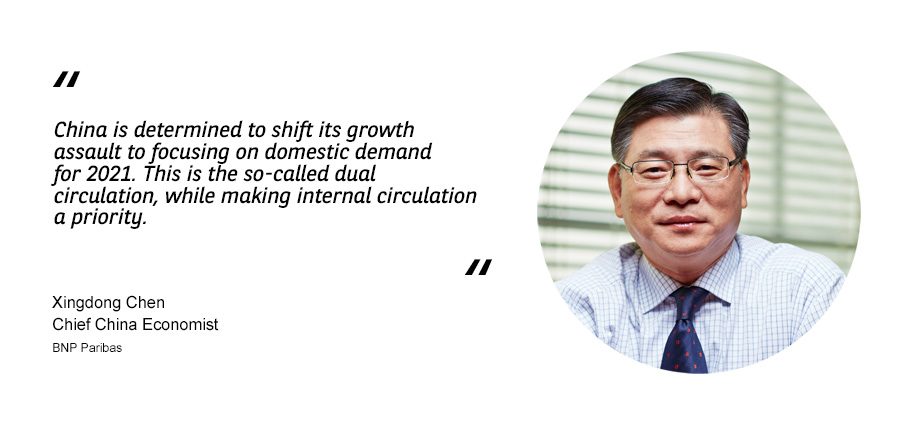
Still, BNP Paribas sees potential for
the outcome of the U.S. Presidential elections in November to improve the
situation. If Joe Biden, who leads the opinion polls, claims the White House,
his approach to trade negotiations with China and the rest of the world “may be
more institutional and more predictable,” says Mr. Chen.
In the face of these external uncertainties,
though, “China is determined to shift its growth assault to focusing on
domestic demand for 2021. This is the so-called dual circulation, while making
internal circulation a priority,” he adds.
